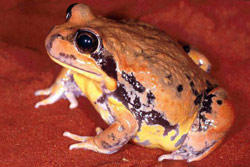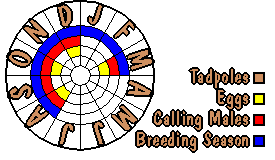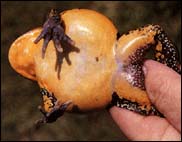Limnodynastes interioris
Giant Banjo Frog
Also: Giant Bullfrog, Giant Pobblebonk, Great Bullfrog, Inland Banjo Frog

+ 47 kb Giant Banjo Frog (Limnodynastes interioris)
A large frog (Victoria's largest) and a powerfully built burrower and jumper. The Great Bullfrog is quite uncommon in Victoria where it is largely restricted to the floodplains of the Murray River. Here, and in the rest of its range through the Murray Darling basin in New South Wales, it spends most of its life concealed underground, emerging only after rains to feed and spawn.
Distribution and habitat

Adults frequent open and disturbed areas and woodlands. They are often found in quite dry forest but are usually associated with floodplains. Eggs are spawned in water, in swamps, ponds, and dams, and sometimes in flooded burrows along stream banks. Tadpoles are aquatic and usually associated with slow moving or still water.
There is a detailed distribution map available for: Victoria.
Calling
Males call, either floating in vegetation or in burrows along the streambank. The call is a short deep hollow note similar to that of Limnodynastes dumerili, but of a much lower pitch - "gunk", "donk", or reverberating "bonk".
Copyright Murray Littlejohn. Recorded by Murray Littlejohn. Must not be reproduced without permission.
Life cycle

Distinguishing characteristics
 Adult
length: 70-90mm.
Adult
length: 70-90mm.
The eggs are pigmented and contained within a large (1200-1800mm diameter foam mass concealed in aquatic vegetation or flooded burrows. The tadpoles are large, dark brown, or black with dark grey fins. The fins, and often the body, have darker flecks.
Visible features
Presented here is the information stored in the frogs.org.au database which is used to identify frogs based on their appearance. It is intended to be used in a key guide for separating species so some of the information (for example, back colours) may be rather non-specific. The system is currently being developed - if you notice errors in the data, please write to Dave Black at the address at the bottom of the page.
Important note: This information details only the appearance of the frog. If an "or" appears in the description, this may mean either that there is some variation within the species or that the feature might be observed differently by different people. For example, if a frog has very small toe pads, it may be listed as having "Toe pads: present or absent".
Size
Up to greater than 90mm
Eyes, hands, and feet
Pupils: horizontal
Toe pads: absent
Webbing on feet: no webbing
Belly
Texture: smooth
Pattern: plain
Colour: single colour
Back
Texture: smooth or warty
Pattern: plain or spotted
Colour: multi-coloured
Glands and tubercles
Parotoid gland: absent
Tibial gland: present
Metatarsal tubercles: keratinised glands present (black / brown)
Similar species (note: this version was written for Victorian species).
Distinguished from Heleioporus australiacus and both Neobatrachus species (Neobatrachus pictus and Neobatrachus sudelli) by its prominent tibial gland and horizontal pupil. This frog is most often confused with Limnodynastes dumerili from which it can be easily distinguished by having a bright orange or yellow belly. L. dumerili has a plain white or orange/yellow belly that is heavily mottled with black or steel grey.
The scientific names of Limnodynastes interioris
- Limnodynastes dorsalis interioris (Fry 1913)
- Limnodynastes interioris (Fry 1913)

